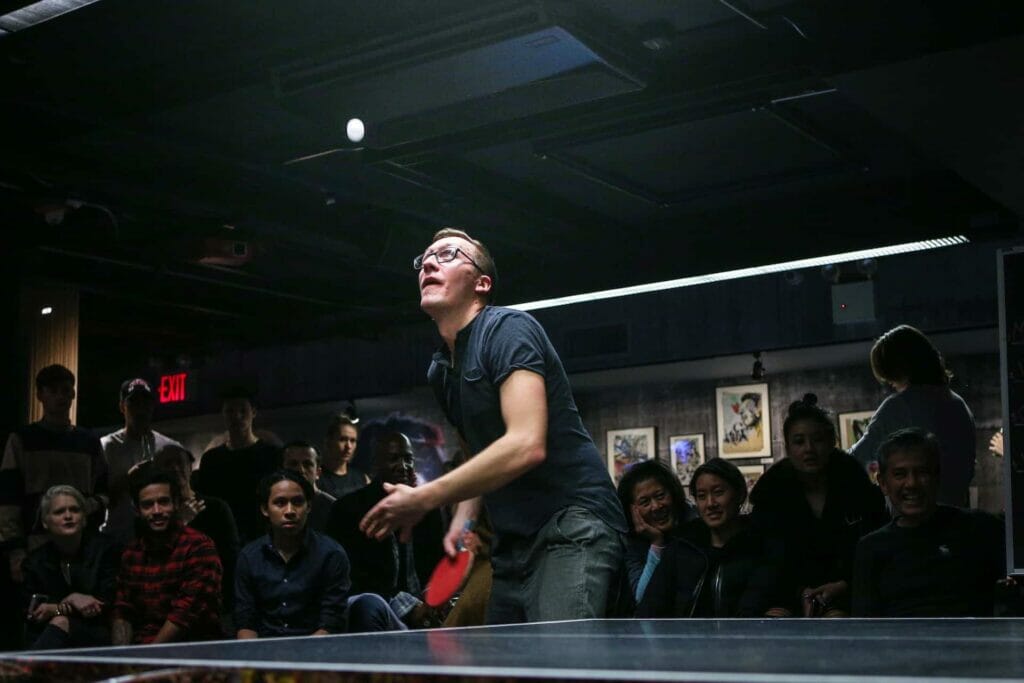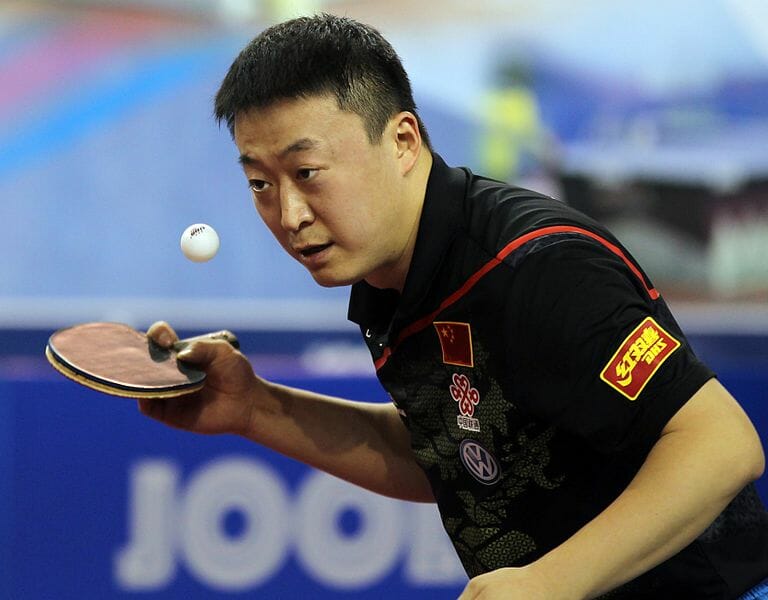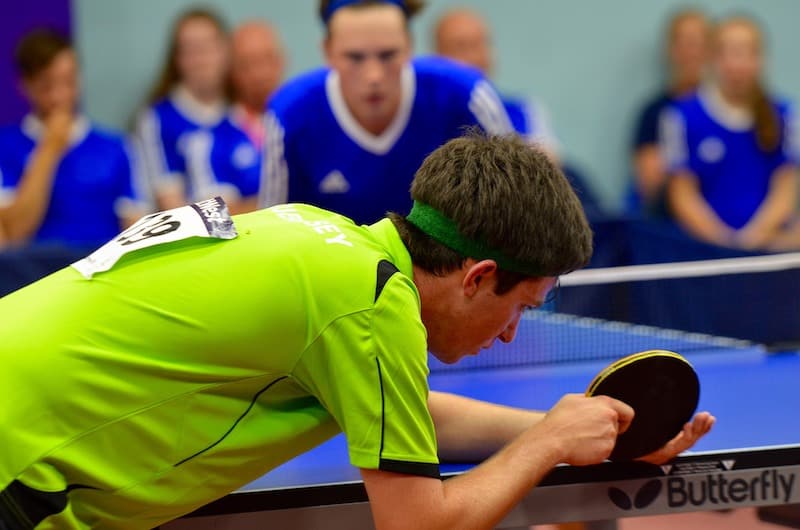The quickest way to improve your ping pong game is by using a better serve. I know improving my serve helped me a crazy amount when I was playing in tournaments in Suffolk (Yes, I’m British).
Here are the 5 best ping pong serves:
- Tomahawk/backhand tomahawk serve — Kenta Matsudaira
- Pendulum serve — Ma Long
- Ghost serve — Ma Lin
- Shovel serve — Xu Xin
- Pendulum/fast down-the-line serve — Jan Ove Waldner
In this article, you’ll learn how each of these players used these table tennis serves, why they are effective, and ultimately, how you can use them in your game!
The Importance of a Good Ping Pong Serve
Serving is the only time you have complete control of the ball, so you have complete freedom to dictate the beginning of the rally. This means you can play to your strengths and your opponent’s weaknesses selectively.
Facing an opponent with a poor backhand attack? A fast serve deep to the backhand could be a good choice. Perhaps a topspin pendulum serve (see below for a how-to).
Countering a player’s weakness with an effective ping pong serve gives you a strong start to a rally, so you’d be foolish not to make use of such a golden opportunity. But here lies the issue. For one, you need to be able to read the game to decipher which serves to give you an advantage, and two, you need to be able to execute said serve effectively. Only then do you have one of the best serves in table tennis.
This means you need a lot of practice to improve the quality of each of your serves. You must get factors such as spin, placement, and deception just right. Oh, and you need to ensure they are legal serves, too! So, there is no hiding the ball with your throwing arm.
Read More: Basic Table Tennis Skills
The Best Ping Pong Serves in Professional Play
*When discussing technique, we describe the steps for right-handers. If you’re a lefty, just do the opposite!
1. Tomahawk/Backhand Tomahawk Serve — Kenta Matsudaira
Kenta Matsudaira is a master of the tomahawk, which I feel is one of the best serves in table tennis if used correctly.
Why Should You Use the Tomahawk Serve?
The tomahawk is a unique serve. Not only do you position yourself differently for the setup, but you’ll also often aim short for the forehand. This contrasts the popular pendulum serve, which your opponent will predominantly strike with their backhand.
As such, opponents are far less used to tackling the tomahawk serve, so it can work rather well. It was my favorite serve as a junior player and got me through many tough matches.
How to Perform the Tomahawk Serve
Unlike most other forehand serves, you face the table for the tomahawk rather than away from it. The serving motion is similar to throwing an actual tomahawk, hence the name.
- Stand anywhere behind the backhand side of the table
- Feet shoulder-width apart with your right foot behind and angled outward
- Your racket is in the ready position
- Knees bent
- Throw the ball in line with your right foot and draw your racket in front of your shoulder.
- Keep most of your weight on your back foot.
- Extend your arm at the elbow to contact the ball with your forehand rubber.
How Can You Use The Backhand Tomahawk Serve?
The performance for the backhand tomahawk is largely the same. The main differences are:
- Turn your racket the opposite way to expose your backhand side before contact.
- Strike the ball in front of the body rather than to the side.
- Otherwise, you do not have the correct angle to play this sidespin serve.
Avoid This Mistake With The Tomahawk Serve
Generally, playing repeated tomahawk serves is not advisable as they often drift long. Once your opponent makes the adjustment, the ball is there for a free attack.
However, Matsudaira keeps himself much safer by varying his tomahawk serve. He uses a combination of both the regular and backhand tomahawk.
With an opposing sidespin and a near-identical setup, it is hard for his opponents to commit to a strong attack. Instead, they often play more passively. This results in many points won outright from the serve and many more from easy third-ball sitters.
2. Pendulum Serve — Ma Long
Naturally, the greatest player of all time has a good serve. Ma Long’s serve is nothing especially fancy — it’s just a regular pendulum serve.
However, he has become a master at being deceptive. This makes his pendulum one of the best table tennis serves, as it is also loaded with spin. A false read often leads to an easy point for the Chinaman.
If you pay close attention, you’ll also notice that Ma Long occasionally fakes a reverse pendulum serve. He does this by altering his racket motion after contact with the ball. He rotates his racket inwards so that his forehand is facing in front of his body instead of away from it.
Why Should You Use the Pendulum Serve?
The pendulum serve is not only one of the easiest to learn but also the most popular. It is both the most popular professional ping pong serve and the most popular amateur serves.
One of the reasons for this is that it is very easy to control compared to other table tennis serves. This gives you more freedom to mix up spin combinations, speed, and placement. These are all essential variables for giving your opponent trouble.
So do yourself a favor and try learning this simple serve. You should pick it up much quicker than others. It’s one of the first services I teach to new players.
How to Perform the Pendulum Serve

- Stand perpendicular to the table with your left hip close to the left corner
- Position your left foot forward and your right foot back, and turn your right foot outward slightly
- Lean forward with your racket in front of you and your elbow bent
- Throw the ball and move your racket away from the table while elevating your elbow
- Transfer weight to your back leg
- Raise the handle to adjust to sidespin
- Transfer your weight back onto your front leg
- Bring your racket back to meet the ball and brush it on the side with your forehand rubber
- Engage your elbow and wrist at contact
- Step inward with your right foot so that you are facing the table and ready to make a return
Read More: Ping Pong Grips: Every Way You Can Hold a Paddle
3. Ghost Serve — Ma Lin
Ma Lin’s ghost serve is a backspin serve loaded with so much spin that the ball bounces on his opponent’s side, and the backspin draws the ball back to the net.
When discussing the best ping pong serves, ghosts are rarely in the mix. This is because to perform the ghost serve consistently, you usually need to kill the forward movement of the ball to allow the spin to dominate. This means serving the ball high, which is bad when playing competitively.
It seems nobody told Ma Lin this because he can keep his ghost serve low, so it is very difficult to attack. Undoubtedly, it’s one of the best table tennis serves of all time.
Why Should You Use the Ghost Serve?
The ghost serve is loaded with heavy backspin, making it difficult to return. However, while the ghost can be a good serve, performing it properly is incredibly challenging. This is because many players serve the ball too high to allow the spin to bring it back, making it easy to attack.
Therefore, a standard chop serve is usually a better choice for most players. Only the elites can safely use this pro ping pong serve with consistency.
I never do the ghost serve, but rather the chop serve. The ghost is far too difficult for me, and I’ve been playing for over a decade.
How to Perform the Ghost Serve

Fortunately, the ghost serve draws many parallels from the pendulum serve. Your body positioning is identical, it is just the serving motion itself that differs.
- Stand perpendicular to the table with your left hip close to the left corner
- Position your left foot forward and your right foot back, and turn your right foot outward slightly
- Lean forward with your racket in front of you and your elbow bent
- Throw the ball and move your racket away from it by pivoting at the elbow
- Transfer weight to your back leg
- Keep your forehand rubber facing the ceiling
- Transfer your weight back onto your front leg
- Bring your racket back to meet the ball and brush it on the bottom with your forehand rubber
- Focus on swift wrist action at contact
- Aim for the first bounce to occur in the first half of your side of the table (this will help ensure there is less forward momentum allowing spin to take over)
- Step inward with your right foot so that you are facing the table and ready to make a return
Read More: The Best Ping Pong Robots: Reviews and Buyer’s Guide
4. Shovel Serve — Xu Xin
Xu Xin is a good example of a diverse server, much like Ma Lin. He also uses a penhold grip, which gives him great wrist flexibility — perfect for serving. Like other deceptive servers, Xu Xin often fakes his sidespin motion to try to fool his opponents. He does this by performing a pendulum and faking a reverse pendulum serve.
However, Xu Xin also has a tendency for table tennis serving that you seldom see in other players. Sometimes, when performing his pendulum serve, he doesn’t try to fake a reverse one. Instead, after hitting his pendulum serve, he draws his racket behind his body out of view. This is another way to obscure the spin he imparts on the ball.
Given that I have already discussed the serving motion for the pendulum serve, let’s take a look at the shovel serve. This is Xu Xin’s go-to table tennis serve recently.
Why Should You Use the Shovel Serve?
The shovel serve is an excellent way to set up your forehand as it produces left-to-right sidespin. It pairs up nicely with the pendulum, producing the opposite type of spin.
It is also far easier to perform than the reverse pendulum serve, which is its main competitor. Therefore, you don’t need to be an advanced player to start using it. Beginners and intermediate players can incorporate it into their game easily. Considering all of these factors, I think it is easily one of the best serves in ping pong.
How to Perform the Shovel Serve

- Stand perpendicular to the table with your left hip close to the left corner
- Position your left foot forward and your right foot back, and turn your right foot outward slightly
- Lean forward with your racket in front of you and your elbow bent
- Throw the ball and move your racket away from it by rotating your body away from the table
- Keep your elbow fairly close to your body
- Transfer weight to your back leg
- Angle your racket for sidespin by keeping your racket parallel to the ground (the opposite sidespin to the pendulum)
- Transfer your weight back onto your front leg
- Bring your racket forward to meet the ball and brush it on the back with your forehand rubber
- Step inward with your right foot so that you are facing the table and ready to make a return
5. Pendulum/Fast Down-the-Line Serve — Jan Ove Waldner
Jan Ove Waldner is a fan-favorite table tennis player. He was an expert at reading the game and a master at producing spin. Back during his heyday, the serving rules were different. You could obscure the ball with your non-playing arm, which was a major advantage for technical servers.
Waldner exploited this rule to incredible effect in table tennis. His best table tennis serves were almost impossible to read, making him one of the deadliest servers of his era.
He used various table tennis serve techniques, but fundamentally, most of Waldner’s serves were pendulums. Much like the modern Chinese players we have discussed thus far, he fakes his pendulum serve for a reverse pendulum fairly often.
However, one tendency Waldner had more than most was his quick down-the-line serve. Sometimes, this was a pendulum, and other times, it was more of a reverse pendulum. Neither had much spin, but both were fast and deadly accurate.
Why Should You Use a Fast Down-the-Line Serve?
A fast down-the-line serve is a great way to catch your opponent off-guard. Not only does this long serve give you a high probability of winning the point, provided you use it sparingly, but it also helps instill uncertainty into your opponent’s mind.
They will be more cautious about pre-emptively committing to an attack as they know that they could receive a fast down-the-line serve at any point.
Once again, anyone can learn this type of serve, and indeed everyone should try to use it every so often in match play.
How to Perform a Fast Down-the-Line Serve
- Stand perpendicular to the table with your left hip close to the left corner
- Position your left foot forward and your right foot back, and turn your right foot outward slightly
- Lean forward with your racket in front of you and your elbow bent
- Throw the ball and move your racket away from the table while elevating your elbow
- Transfer weight to your back leg
- Raise the handle to adjust to sidespin
- Transfer your weight back onto your front leg
- As you are about to meet the ball, adjust your racket angle so that it is flatter and contact the ball more directly rather than using a brushing motion
- Aim to play the ball close to the left edge of the table
- Step inward with your right foot so that you are facing the table and ready to make a return
Remember, the key to an effective down-the-line serve is pace, accuracy, and conditioning. I recommend only throwing out a maximum of a few of these per game. The moment your opponent expects it, it ceases to be a good serve anymore.
The best way to set up for this serve is to condition your opponent by serving both short and long deep to your opponent’s backhand.
Read More: Practice Table Tennis Alone
The Best Ping Pong Serve Tips

Before you embark on trying all of the serves we have discussed today, I thought I’d quickly produce a checklist of components for you to work on. Remember, take your time, and don’t expect killer serves overnight. It took me years to develop tricky serves, and I’m still improving them to this day.
- Focus on brushing motion — this is what produces spin
- Learn at least three serves — you need options against different types of players
- Vary your placement — to keep your opponent guessing
- Vary your spin — to prevent your opponent from getting into a rhythm and becoming confident
- Be deceptive! — try to fool your opponents, this will win you more points
Final Thoughts
Serves are the most important shots in table tennis. So while practicing smashes and drives is a lot of fun, you should be allocating a good chunk of your training time to developing the best ping pong serves possible.
What the best players in the world all have in common is that their serves are of very high quality. And what’s exciting is everyone’s serves are different. Even if players are technically performing the same serve, we all put our own unique spin on our serves (no pun intended).
So while the likes of the pendulum, tomahawk, and shovel are some of the best ping pong, you should practice as many different types as you can to see what works for you. It shouldn’t be long before you find a collection of serves you really connect with. Then it’s just a matter of practice, practice, practice!
Frequently Asked Questions
What Is the Most Effective Serve in Ping Pong?
I feel that the pendulum ping pong serve is the best serve. Almost all players at an intermediate level and above use it, and for good reason. It’s easy to perform and easy to vary, which leads to a lot of successful points.
What Is the Hardest Serve to Return in Table Tennis?
Again, a quality pendulum service is very difficult to return. However, I’ve found that elite servers who use the reverse pendulum or shovel serve are more difficult to handle. It’s mostly down to personal preference.
Is the Ghost Serve Legal?
The ghost serve is 100% legal. It’s just few players use it as it is very difficult to keep yourself safe. Generally, the ghost serve is something a little flashy reserved for training.
What Is the Easiest Serve in Table Tennis?
The most simple serve to perform is probably either the backhand chop or backhand sidespin serve. They both have a far more natural feeling than other serves. Beginners pick them up a lot quicker than they do forehand chop or pendulum serves.
Freelance writer. Table tennis enthusiast. Lover of all things online. When I’m not working on my loop game I’m probably binge-watching some fantasy show.






